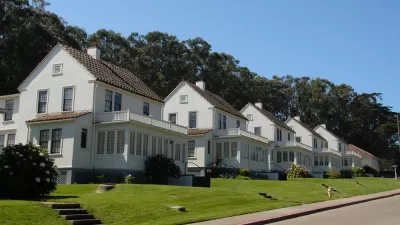Gone are the days of drab cinderblock housing for America's military families. Taking advantage of an initiative passed by Congress in 1996, today's privatized military housing developments are larger and packed with modern amenities.
McGuire-Fort Dix-Lakehurst joint base is following a national trend among military bases by taking the opportunity to update and renovate their on-base housing stock. And the top end of the housing being built could give McMansions a run for their money. As Jill P. Capuzzo, of The New York Times reports, at around 4,500-square-feet, complete with "four bedrooms, a three-car garage, arched ceilings, a wet bar, an enclosed sunroom and a patio with a built-in barbecue pit," homes for generals are quite sizable, with numerous amenities.
Enabling this redevelopment is the 1996 Military Housing Privatization Initiative, allowing private developers access to upgrade military housing stock. As Capuzzo reports, "[u]nder the the initiative's rules, the developers build or renovate military homes, which they own and rent out to military personnel, and continue to manage and maintain for the next 50 years. As of February 2012, there were 105 of these privatized housing projects nationwide, with a total 191,905 homes, according to the Department of Defense."
At the McGuire-Fort Dix development, the new housing has been a boon to military families with "nearly 95 percent of the housing" occupied by military members and their families. A waiting list of up to a year remains for some of the newly-constructed homes.
FULL STORY: A Long Way From Cinderblock

Maui's Vacation Rental Debate Turns Ugly
Verbal attacks, misinformation campaigns and fistfights plague a high-stakes debate to convert thousands of vacation rentals into long-term housing.

Planetizen Federal Action Tracker
A weekly monitor of how Trump’s orders and actions are impacting planners and planning in America.

In Urban Planning, AI Prompting Could be the New Design Thinking
Creativity has long been key to great urban design. What if we see AI as our new creative partner?

Massachusetts Budget Helps Close MBTA Budget Gap
The budget signed by Gov. Maura Healey includes $470 million in MBTA funding for the next fiscal year.

Milwaukee Launches Vision Zero Plan
Seven years after the city signed its Complete Streets Policy, the city is doubling down on its efforts to eliminate traffic deaths.

Portland Raises Parking Fees to Pay for Street Maintenance
The city is struggling to bridge a massive budget gap at the Bureau of Transportation, which largely depleted its reserves during the Civd-19 pandemic.
Urban Design for Planners 1: Software Tools
This six-course series explores essential urban design concepts using open source software and equips planners with the tools they need to participate fully in the urban design process.
Planning for Universal Design
Learn the tools for implementing Universal Design in planning regulations.
Gallatin County Department of Planning & Community Development
Heyer Gruel & Associates PA
JM Goldson LLC
City of Camden Redevelopment Agency
City of Astoria
Transportation Research & Education Center (TREC) at Portland State University
Jefferson Parish Government
Camden Redevelopment Agency
City of Claremont




























